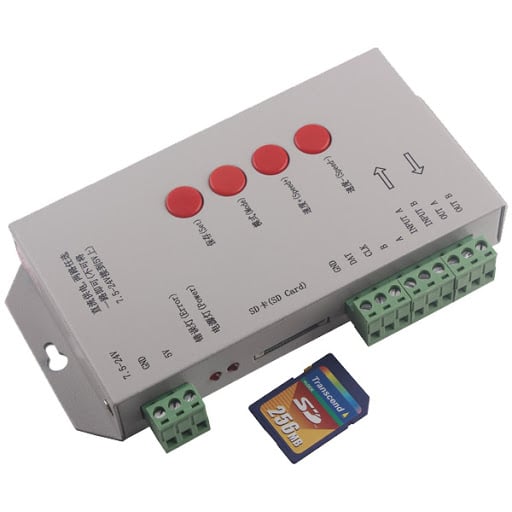Synchronizing Multiple K-1000C Controllers for Large LED Displays
Introduction
While the K-1000C is a powerful single-port controller ideal for medium-scale LED pixel installations, sometimes your project will exceed its 2048-pixel limit or require distributed control across a large area. In these cases, you can synchronize multiple K-1000C controllers to work together, creating seamless effects across your entire LED display.
Why Synchronize Multiple K-1000C Controllers?
- Expand Pixel Count: Control more than 2048 pixels by splitting your project across several controllers.
- Distributed Installations: Place controllers closer to different LED sections to reduce wiring complexity and signal loss.
- Redundancy: If one controller fails, others can continue operating.
Methods for Synchronizing K-1000C Controllers
1. SD Card Program Synchronization
The most common method is to use identical SD cards in each controller, each loaded with the same effect files generated by LED Edit.
Steps:
- Design your full display in LED Edit, splitting the project into sections (one per controller).
- Export the effect files for each section, ensuring all files have the same name and are saved in the same order on each SD card.
- Insert the corresponding SD card into each K-1000C controller.
- Power on all controllers simultaneously (use a power strip or relay for best results).
Tips:
- Use the “Multi-Controller” or “Cascade” mode in LED Edit if available.
- Ensure all controllers use the same firmware version for best synchronization.
- For best results, use a master power switch to turn all controllers on at the same time.
2. DMX Synchronization (Advanced)
If your installation requires more precise timing or remote triggering, you can use the DMX input on each K-1000C. This requires a DMX master controller or console to send timing signals to all K-1000C units.
Steps:
- Connect all K-1000C controllers to the same DMX bus.
- Assign unique DMX addresses to each controller.
- Use your DMX console to trigger effects or scenes simultaneously.
Best Practices
- Power On Simultaneously: Use a single power source or relay to ensure all controllers start at the same time.
- File Consistency: Double-check that all SD cards have the correct files in the same order.
- Cable Quality: Use shielded data cables and proper power injection to avoid signal loss.
- Testing: Test each controller individually, then together, to ensure seamless synchronization.
Troubleshooting
- Out-of-Sync Effects: Reformat SD cards, re-export files, and ensure simultaneous power-up.
- Signal Issues: Use shorter, high-quality cables and check for proper grounding.
- Controller Not Responding: Check SD card format (FAT32), file names, and power supply.
Conclusion
Synchronizing multiple K-1000C controllers allows you to scale your LED projects beyond a single controller’s limits. With careful planning and setup, you can achieve stunning, seamless effects across large displays.
